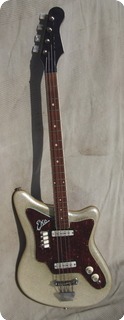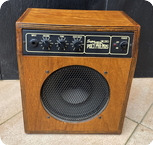Eko / 1100/MB/2 / 1963 / Gold Sparkle / Bass
EKO 1100/MB/2 Bass Gold Sparkle, Two Pickups, Ex ++ code BA669
Made in Italy early sixties electronics works fine and it's ready to play lightweight with thin and fast neck, absolutely gorgeous!
Due Pickup Completamente regolabili per ottenere un equilibrio sonoro o una spinta sui bassi e sugli alti, Ponte completamente regolabile, con sellette per regolare lo spazio tra le interlinee, Tono ricco, profondo e chiaro, il basso è molto facile da suonare per il suo manico agevole e morbido.Doppio Cutaway Selettore di Tono e Volume,Switch M 1 2 3 per la selezione dei pickup, Manico rinforzato con un truss rod d'acciaio, 20 TAsti con segnatasti Perlati.
Available with one to four pickups (500-1, 500-2, 500-3, 500-4), with a vibrato (symbolized by suffix ‘V’) or without, the 500 was a mainstay of the Eko range from early 1962 through 1965 and was distributed in virtually every country of the planet, backed by a worldwide promotional campaign.
Small stores like there were many back then, liberally mixing TV, radio, records, possibly house appliances too, often had one or two Eko 500 in display. They were irresistible eye-catchers in the shop windows. Since those retailers were generally just as clueless about setting up a guitar as the newbies who were their customers, and as factory setup was often a bit hasty, old Eko sparkle guitars have retained a questionable repute: “All for the look, nothing for the sound”.
Let us face it, Eko solidbody electrics of the pre-1965 era all have some shortcomings as far as sound and ergonomics are concerned. The so-called ‘Double Polarity’ pickups are low output. The crazy intricacy of the circuitry is no warrant to its reliability. Some of the tones offered by the slide-switch selector are of little to no use.
In my opinion the bridge deserves the sharpest gripe. Not only is it inspired from the Jazzmaster with its infamous rattling saddles but it tends to rest where it should not, upon the plastic scratchplate. This bridge is an accomplished sustain killer when the problem is not cured (fortunately it can be).
With an adequate setup and a little TLC an Eko 500 can still be made an instrument that stays in tune, sounds quite good with a decent sustain and plays real good thanks to its smooth and thin neck. This neck continues the headstock shape and the propeller inlays of the 400 series but aside from that is totally different: much thinner oval profile (quite similar to contemporary Fender necks), bolted-on and not glued-in construction, standard fret wire instead of jumbo frets, and longer scale length.
1100-2
There was also a bass version, called model 1100-2 (which means it is always fitted with two pickups), based on the same body and the same electronics, with the same choice of finishes and a parallel evolution over time, and a 30” scale length.
Specific appointments of the first Eko 500s:
- scale length 632 mm (nearly 25”)
- no side fret markers
- body thickness 35 mm
- “Made in Italy” simply hot-stamped on back of headstock
1. The Early Months (1962 first half)Those archaic versions share one or several of the following features:
- same black pickups as the 400 series
- waist and forearm contouring
- jumbo frets
- “spaghetti logo” (raised lettering directly glued on pickguard) or same logo as the 400 series
- Ekomaster vibrato assembly
- non-trem version with same tailpiece as the 400 (with two exposed bolts on top and two others on body back)
2. Classic 1962 Version (from mid-1962 to early 1963)
- classic “biscuit” logo (one-piece black and white plastic moulding)
- vibrato mechanism fastened to a large chrome plate
- non-trem version: tailpiece has no exposed bolts on either side of body
3. 1963 Version
- vibrato mechanism covered by a plastic plate that matches pickguard material
- side fret markers along neck binding
In the course of this generation body thicknesses tend to increase from 35 to 38 mm, while the slot-head screws previously used to fasten pickups and selector to scratchplate are substituted with unslotted screws (they look like rivets).
4. 1964 Version
- new surface-mounted vibrato assembly, known as Model 101
- “Made in Italy” is a white stenciled scroll banner
- back of the neck is sprayed in a sort of greenish sunburst
- black plastic pickup surrounds are added
- scale length reduced to 628 mm (24.3/4”)
- body thickness decreases from 38 to 36 mm
- one-pickup configuration (500-1) is discarded
The very first generation from early 1962 is quite rare. Interestingly the few specimens we have been informed of are equally distributed between Europe and North America, which suggests that LoDuca began selling some 500’s in USA earlier than generally alleged, or that those guitars were marketed through other distributors (the unknown ones who imported the 400 series to the U.S.). Production was discontinued in the course of 1965. There are some extremely rare late models featuring a neck with dots instead of propeller inlays and a natural finish on the back, or even a 820/Condor neck. About equally prevalent on the vintage market are the three main generations of 1962, 1963 and 1964, the earliest one being a little less common due to its shorter production life. There are remarkably almost no transition types between those main types.
http://www.fetishguitars.com
Hendrix Guitars, Italy 
Welcome to HENDRIX VINTAGE
Hendrix Vintage is the first Vintage Collector in Italy with the best Vintage instruments Guitars Bass Amplifiers Effects carefully inspected to guarantee originality and high quality since 1978. All info in site: www.hendrixguitars.com
and also see: http://www.hendrixguitars.com/HendrixVintage.htm
All shipping handled by GLS or Poste Italiane (Europe) or EMS (World) for fast and reliable delivery with tracking. Options: UPS (more expansive) The payment is through money bank transfer (or MoneyGram or Wester Union or Transferwise very easy directly from your credit card or your bank account see the web) Sorry no credit card or Paypal direct. Particular care and attention to create an anti-breakage packaging.














